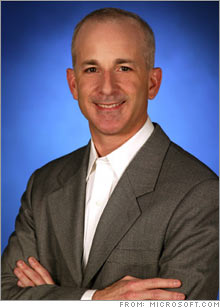|
The man who could fix Windows
Microsoft's new OS chief has to get Redmond to embrace a new model of programming, in which software is constantly being improved instead of updated every 5 years.
NEW YORK (Business 2.0 Magazine) - Steven Sinofsky is a rare bird on Microsoft's Redmond campus -- a manager who actually delivers software on time. As head of product development for Office, he's known for meeting release deadlines. The perpetual beta
He's now been put in charge of Microsoft's Windows group, which has seen endless delays in the release of its new Vista operating system. (Indeed, the recently announced delay of the consumer version of Vista will hold up what would have been the timely release of Sinofsky's Office 2007 since Microsoft wants to release the two products at the same time).
One of Sinofsky's main tasks in his new role will be to revamp the way that software is developed and pushed out the door. And it won't be enough to just crack the whip on deadlines. He'll also have to get Microsoft (Research) to embrace a new model of programming born on the Web -- the "perpetual beta" -- in which programmers continuously improve software with new features rather than wait to roll them up into a big release every few years. That's a big challenge, but if Sinofsky can succeed in that task, he could be headed straight to the top. Indeed, in 2003 Business 2.0 identified him as one of seven executives who might one day succeed Bill Gates. When Microsoft ruled the desktop-software universe, delays didn't matter. Microsoft marketers could announce a product years in advance and keep pushing off the release date -- creating what some critics called "vaporware" -- and partners would fall into line, pledging their support while the software took years to coalesce out of Redmond's fog. But Google (Research) and others have shown a new way of delivering software. Rather than wait until a program is perfect and bug-free, with all the desired features, Google releases it in a so-called "beta," or test version, that consumers can use. Product improvements are then rolled out invisibly -- programmers never stop improving upon the software. Best of all, upgrades don't require the purchase of new software or a lengthy download. That's the model Sinofsky will have to embrace as he also oversees Microsoft's new Windows Live initiative, which includes Web-based software like e-mail and Web search that will be closely integrated into upcoming versions of the Windows operating system. Real time focus groups
With Windows Live, Microsoft can do something it's never done before outside a controlled lab or focus group: It can watch people as they are using its software. And the way people use it can then be fed back into the design of new features and functions. As the desktop version of Windows incorporates more and more data from the Web, desktop and Web software will become fused together. It will become increasingly difficult to tell the difference between the two. As that happens, Sinofsky should be able to apply more and more of the perpetual beta approach to the Windows operating system, too. The more that your desktop software borrows from other bits of software and data on the Web, the more that the whole idea of waiting for new versions of software goes away. Just like you don't have to wait five years for a new version of Amazon.com (Research), you shouldn't have to wait five years for a new version of Windows. It should just improve perpetually and imperceptibly in the background. That's how Sinofsky can get Microsoft to escape from the vaporware trap. Sinofsky is a programmer at heart, and he also understands the Internet. In fact, he was one of the first people to turn Bill Gates onto the subject, well before Netscape launched. As Gates' personal technical assistant in 1993, Sinofsky bought him a book about the Internet as a Christmas present. It's taken more than a decade for Gates & Co. to grasp the implications the Internet has on the way they write software. But Sinofsky's appointment shows that Microsoft realizes that the software industry is changing, and the company can't afford missed deadlines or slow reaction times anymore. Customers weaned on the Web won't wait half a decade for better software, when they can go online and use products that get better every day. _______________________________________________
In 2003, Business 2.0 identified Sinofsky as one of seven "Baby Bills" who could succeed Bill Gates. |
|

